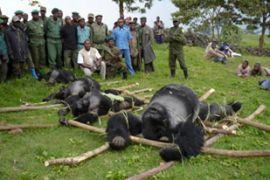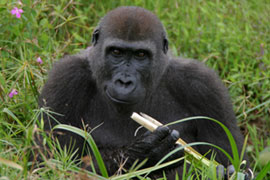Half of primates ‘face extinction’
Report says rising habitat destruction and hunting threating world’s monkeys and apes.

Scientists meeting at the International Primatological Society Congress in Edinburgh, Scotland hope that the report will help spur action to save mankind’s nearest relatives, such as chimpanzees, orang-utans, gibbons and lemurs.
Habitats threatened
The report said rapidly increasingly human populations were fragmenting habitats for orang-utans, gibbons and leaf monkeys.
Primates in Asia were said to be facing the greatest threat, with 71 per cent of species at risk.
The IUCN, which is based in Switzerland, is the world’s oldest and largest global environmental network.
“What is happening in Southeast Asia is terrifying,” Jean-Christophe Vie, deputy chief of the IUCN species programme, said.
“To have a group of animals under such a high level of threat is, quite frankly, unlike anything we have recorded among any other group of species to date.”
In Africa, 37 per cent of species are at risk and the mountain gorilla, found in the jungles of Rwanda, Uganda and Democratic Republic of Congo, remained on the critically endangered list despite a rise in numbers.
“Gorilla meat, chimpanzee meat and meat of other apes fetches a higher price than beef, chicken or fish” in some African countries, Russell Mittermeier, president of Conservation International and head of the IUCN primate specialist group, said.
He also said deforestation was helping the poachers by opening up previously inaccessible regions.
Among primate species most at risk, or “critically endangered”, are the Bouvier’s red colobus, an African monkey which has not been seen in 25 years, and the greater bamboo lemur of Madagascar, of which there are believed to be only about 140 in the wild.
“If you took all the individuals of the top 25 most endangered species and assigned each of them a seat… they probably wouldn’t fill a football stadium,” Mittermeier said.
Gorilla discovery
However, there was a rare piece of good news from the conference as a census by the New York-based Wildlife Conservation Society and the Republic of Congo discovered two new populations of western lowland gorillas in two northern areas of the country.
 |
| Two new populations of the western lowland gorilla were found [Reuters] |
Estimates taken in the 1980s had put the number of western lowland gorillas at less than 100,000 and the population was believed to have fallen by half since then.
The newly discovered animals take the number up to between 175,000 and 225,000.
“This is a very significant discovery because of the terrible decline in population of these magnificent creatures to Ebola and bush meat,” Emma Stokes, one of the research team, said.
The researchers worked out the population figures by identifying and counting the sleeping “nests” gorillas make.
The creatures are too reclusive and shy to count individually.
Mittermeier said that he would like to see more than $100m a year going to help conserve primates in five years time, up from less than $10m now.
“It is not too late for our close cousins the primates, and what we have now is a challenge to turn this around,” he said.